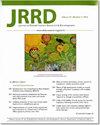Potential neurobiological benefits of exercise in chronic pain and posttraumatic stress disorder: Pilot study.
Q Medicine
Journal of Rehabilitation Research and Development
Pub Date : 2016-01-01
DOI:10.1682/JRRD.2014.10.0267
引用次数: 28
Abstract
This pilot study assessed the effects of cardiopulmonary exercise testing and cardiorespiratory fitness on plasma neuropeptide Y (NPY), allopregnanolone and pregnanolone (ALLO), cortisol, and dehydroepiandrosterone (DHEA), and their association with pain sensitivity. Medication-free trauma-exposed participants were either healthy (n = 7) or experiencing comorbid chronic pain/posttraumatic stress disorder (PTSD) (n = 5). Peak oxygen consumption (VO2) during exercise testing was used to characterize cardiorespiratory fitness. Peak VO2 correlated with baseline and peak NPY levels (r = 0.66, p < 0.05 and r = 0.69, p < 0.05, respectively), as well as exercise-induced changes in ALLO (r = 0.89, p < 0.001) and peak ALLO levels (r = 0.71, p < 0.01). NPY levels at the peak of exercise correlated with pain threshold 30 min after exercise (r = 0.65, p < 0.05), while exercise-induced increases in ALLO correlated with pain tolerance 30 min after exercise (r = 0.64, p < 0.05). In contrast, exercise-induced changes in cortisol and DHEA levels were inversely correlated with pain tolerance after exercise (r = -0.69, p < 0.05 and r = -0.58, p < 0.05, respectively). These data suggest that cardiorespiratory fitness is associated with higher plasma NPY levels and increased ALLO responses to exercise, which in turn relate to pain sensitivity. Future work will examine whether progressive exercise training increases cardiorespiratory fitness in association with increases in NPY and ALLO and reductions in pain sensitivity in chronic pain patients with PTSD.运动对慢性疼痛和创伤后应激障碍的潜在神经生物学益处:初步研究。
本初步研究评估了心肺运动试验和心肺健康对血浆神经肽Y (NPY)、异孕酮和孕酮(ALLO)、皮质醇和脱氢表雄酮(DHEA)的影响,以及它们与疼痛敏感性的关系。无药物创伤暴露的参与者要么健康(n = 7),要么共患慢性疼痛/创伤后应激障碍(PTSD) (n = 5)。运动测试期间的峰值耗氧量(VO2)用于表征心肺健康。峰值VO2与基线和峰值NPY水平(r = 0.66, p < 0.05)、运动诱导的ALLO变化(r = 0.89, p < 0.001)和峰值ALLO水平(r = 0.71, p < 0.01)相关。运动高峰时NPY水平与运动后30 min疼痛阈值相关(r = 0.65, p < 0.05),运动诱导的ALLO水平升高与运动后30 min疼痛耐受性相关(r = 0.64, p < 0.05)。相反,运动引起的皮质醇和DHEA水平变化与运动后疼痛耐受性呈负相关(r = -0.69, p < 0.05和r = -0.58, p < 0.05)。这些数据表明,心肺健康与较高的血浆NPY水平和运动后ALLO反应的增加有关,这反过来又与疼痛敏感性有关。未来的工作将研究渐进式运动训练是否与慢性疼痛合并创伤后应激障碍患者NPY和ALLO的增加以及疼痛敏感性的降低有关。
本文章由计算机程序翻译,如有差异,请以英文原文为准。
求助全文
约1分钟内获得全文
求助全文

 求助内容:
求助内容: 应助结果提醒方式:
应助结果提醒方式:


